Up really early this morning – our kayaking tour leaves at 7 am. Pastry and coffee from Panorama for breakfast, and then my son and I head down to the third floor to catch our tender out to Saldanha. (You need to be at least 12 to go kayaking, which means my wife and daughter get to sleep in today.)
Langebaan is about a 30 minute drive from Saldanha, and there’s no traffic to worry about. There’s only 12 of us on the tour so we’re soon underway. Again we’re provided with boxed snacks and water (upon request), and our smaller shuttle bus is every bit as clean and comfortable as the previous day’s coach bus.
We arrive at the kayaking stand, and our guide arranges for us to use the bathroom of a nearby restaurant before we set off. It’s windy, which may limit the length of our trip – it’s going to be a slog to get back to shore, but our kayak tour operator says he’ll just see how everyone does.
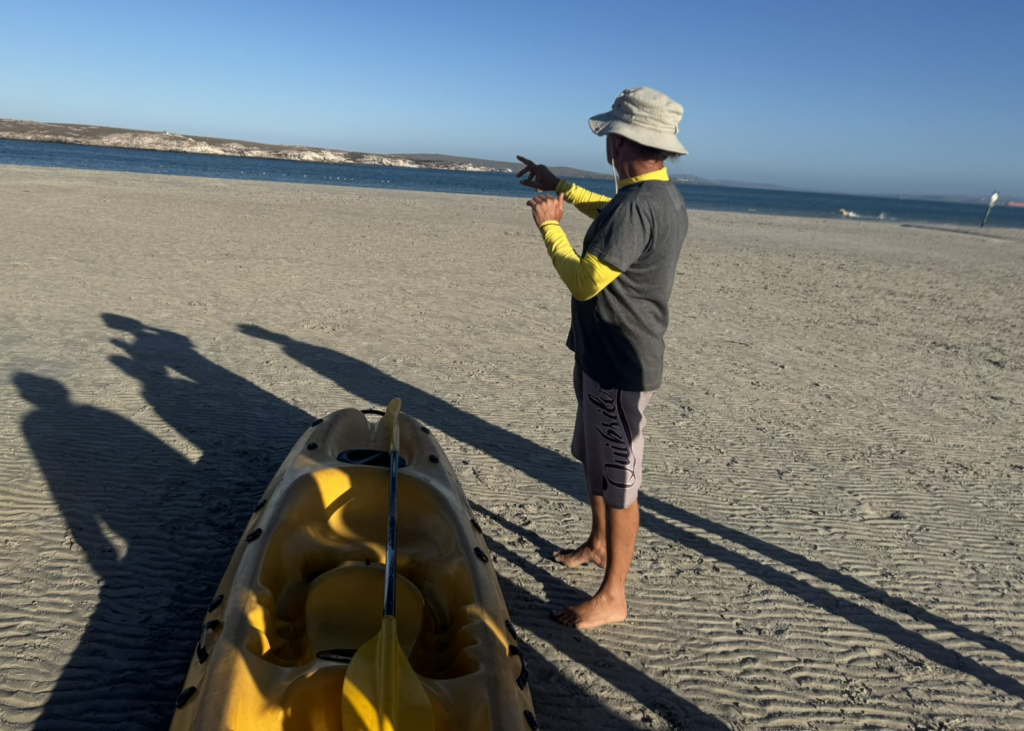
Langebaan beach is beautiful – though cool in the early fall winds. We were too busy packing to take Silversea up on their offer of a shuttle bus to the beach yesterday, so we’re glad we still get the chance to see it even briefly.
We drag our kayaks down to the edge of the water and get ready to launch. Our guide reassures us that we’re definitely going to visit Schaapen island, which is the home to seabirds, seals, and a feral bunny colony. We’re all about the feral bunnies, so I’m glad that portion of the tour is definitely happening.
We had a hard time deciding what to wear that morning, but eventually settled on the unusual combination of sweatshirts and swim shorts. This proves to be the right call – less so the hiking shoes we wore when we should have been wearing sandals or water shoes. My son opts to return his to the shuttle bus, whereas I stubbornly keep mine on.
Somehow I conflated “kayaking the West Coast National Park” with the kind of kayaking we do aboard the Wind, so I was expecting to enter the kayak from a zodiac rather than a beach. Oops. At least I’m wearing merino wool socks, so my feet won’t freeze while we’re out on the open water.
Then we’re off and away:
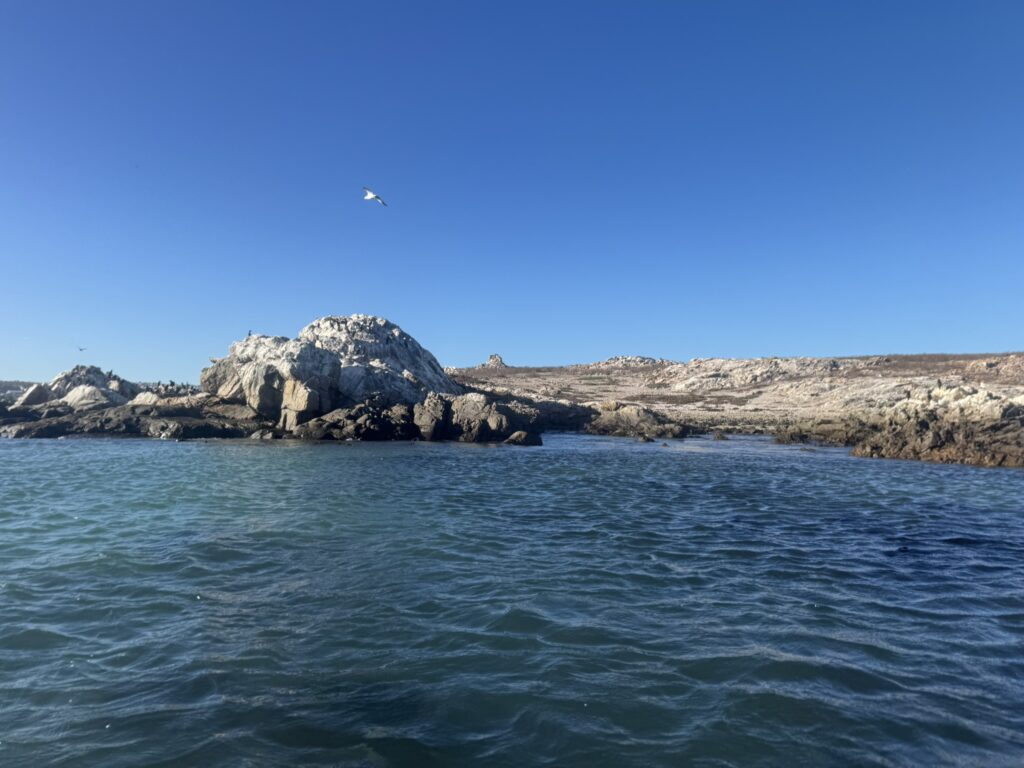
We’re in double kayaks, which makes it easier to get the power we need to get across the windy channel – and it’s not long before we find ourselves next to Schaapen Island, drifting down the coast as we admire seabirds, kelp beds, and the occasional seal.
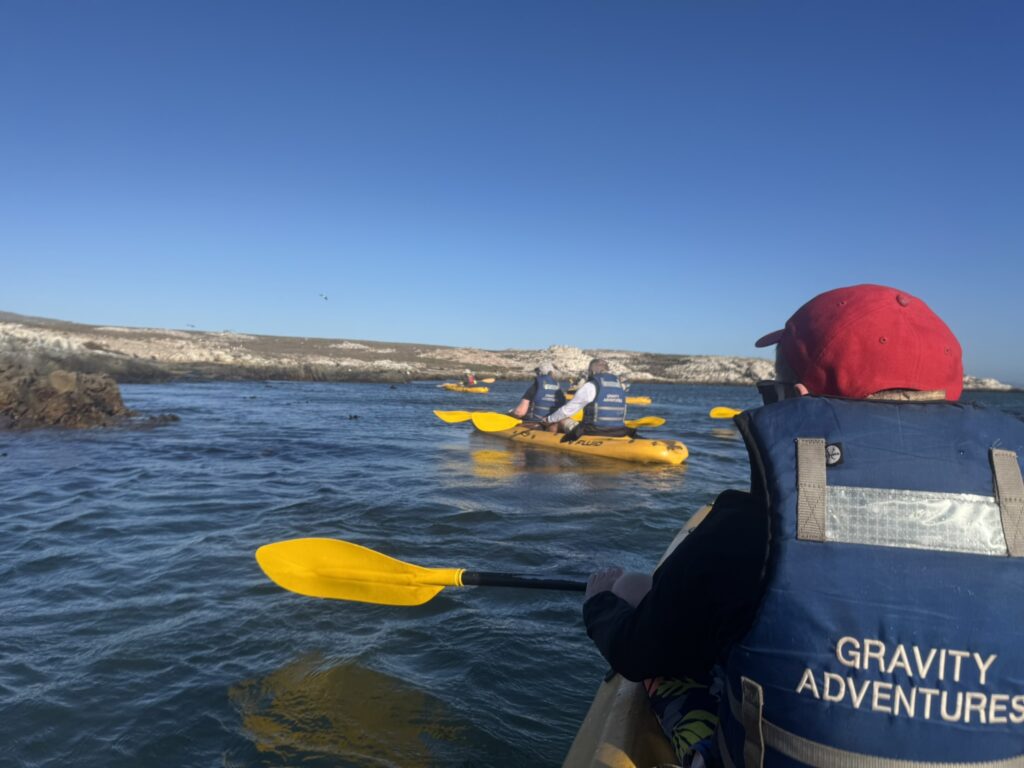
There’s no need to paddle at this point – we just let the wind carry us, steering occasionally as needed. (And it is needed, as we find ourselves caught up on some rocks at one point. But it’s easy enough to back-paddle off of them.)
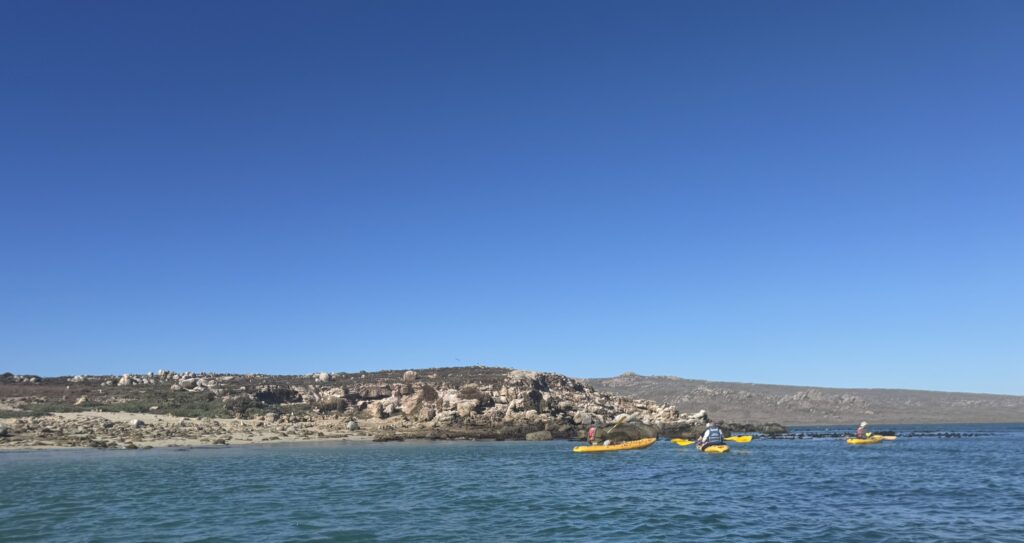
We round the side of the island, and then spot our first feral bunny in the distance!
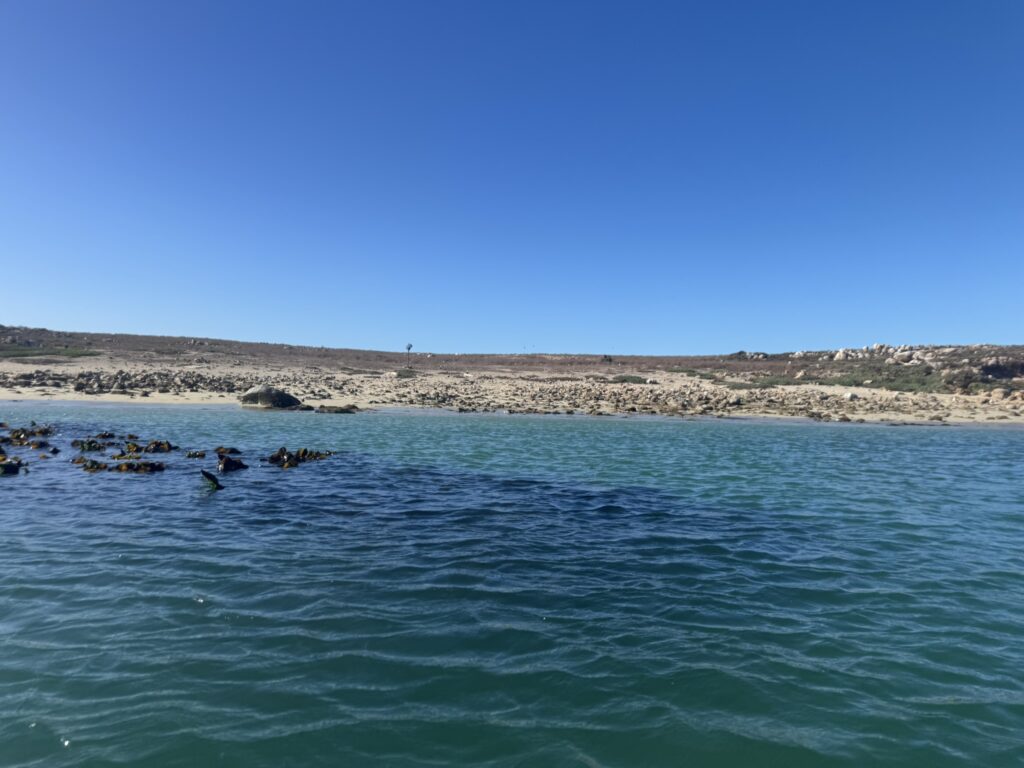
Third speck to the right, and straight ahead until morning
We’re not sure if we’ll make it around the other side of the island, so we do a beach landing instead. It’s a lovely spot to stop.
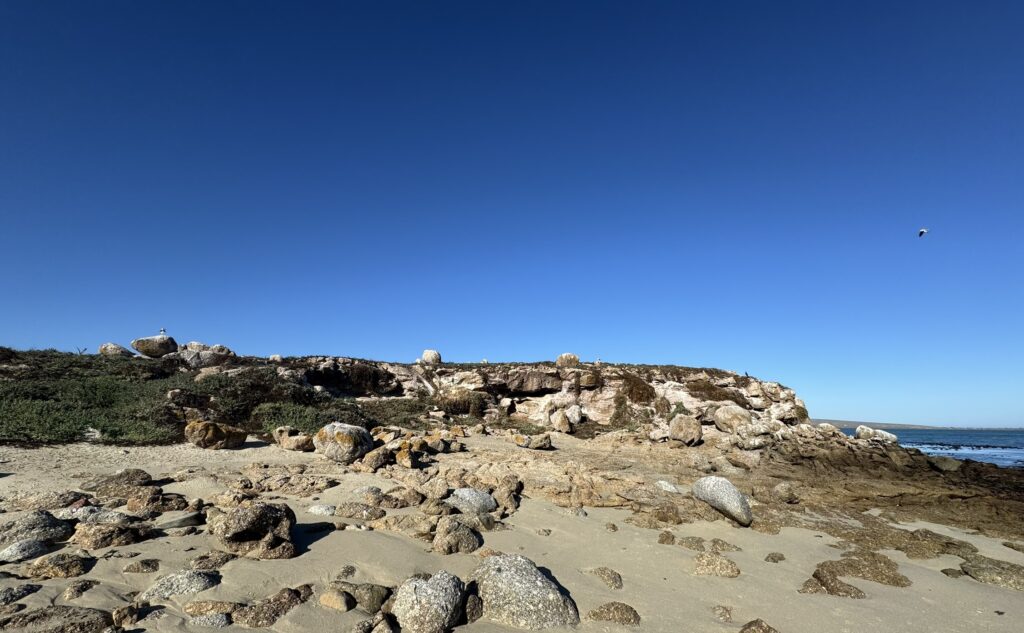
Plenty of birds:
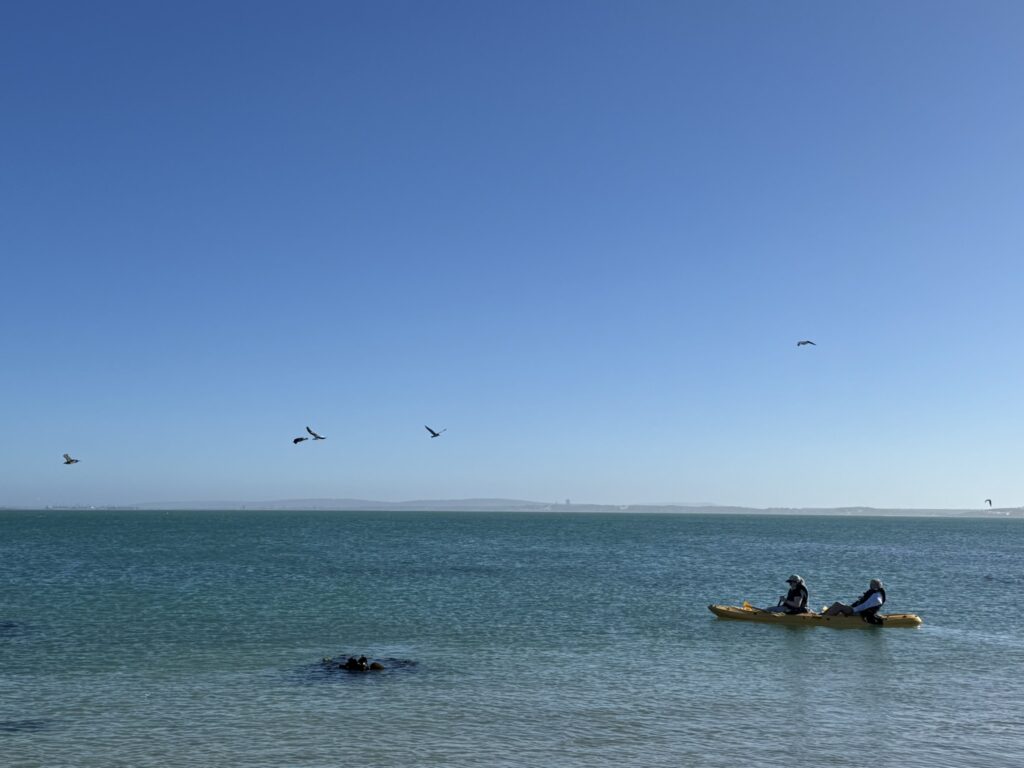
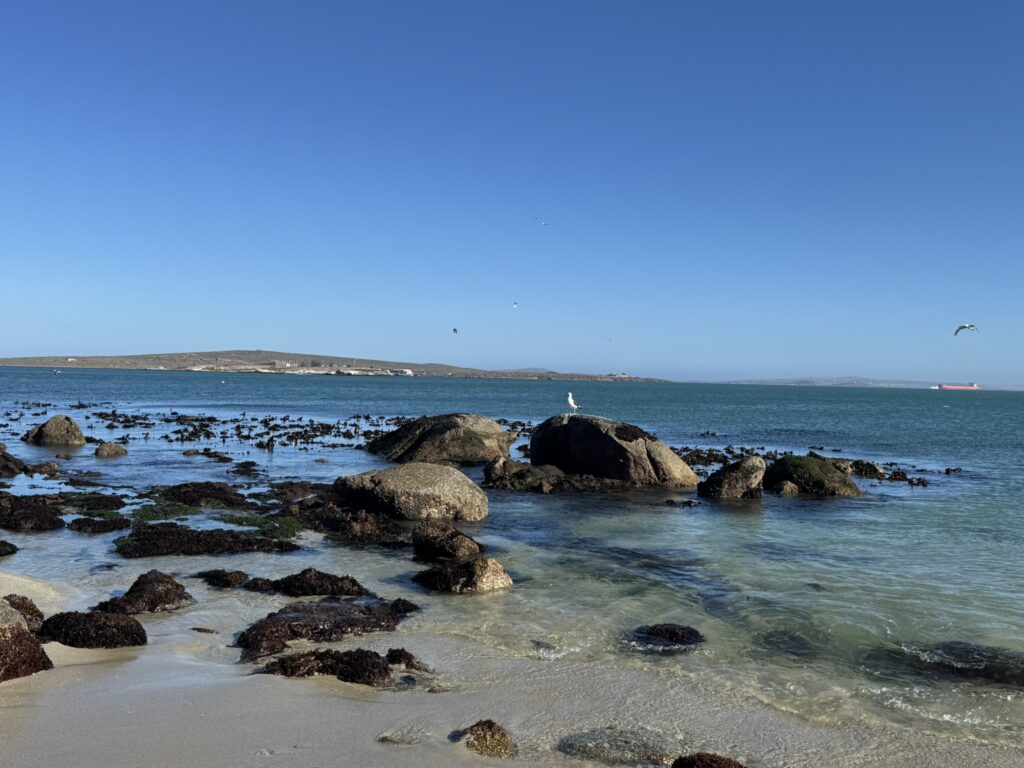
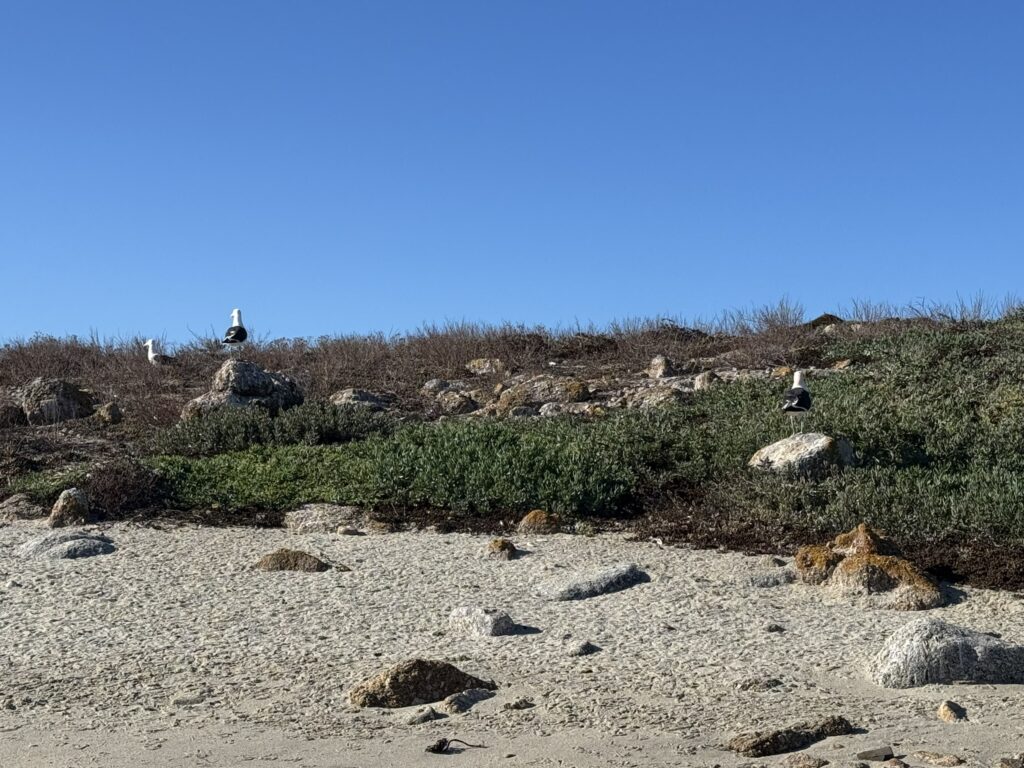
And some beautiful landscape:
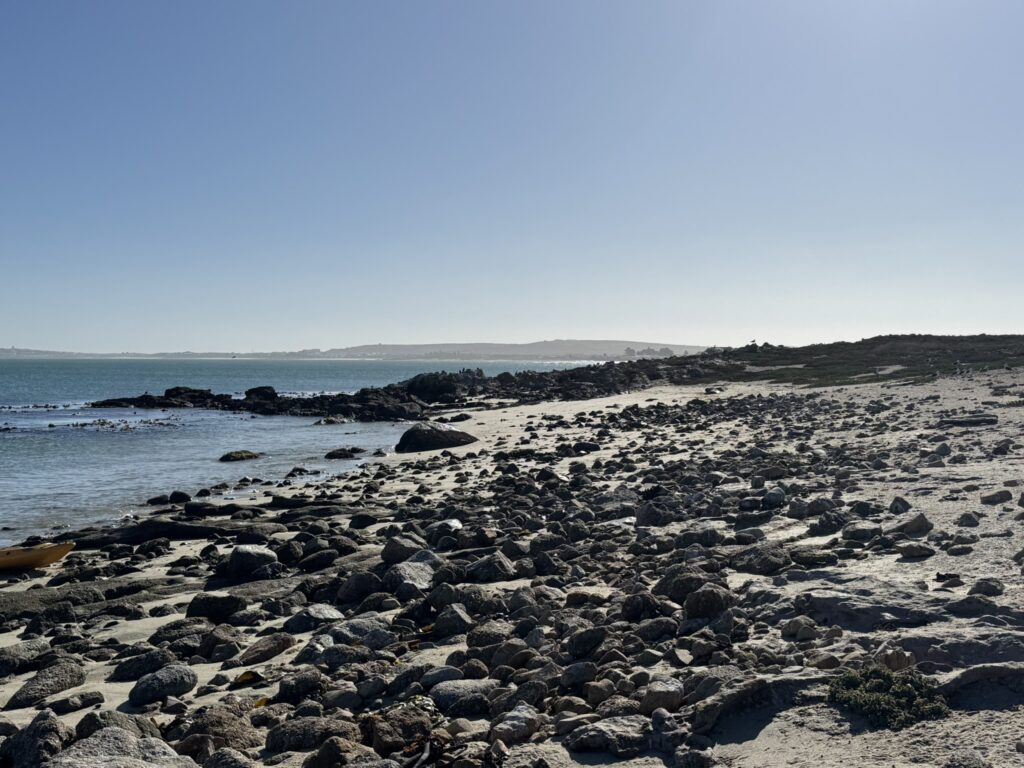
And then we get up close and personal with the feral bunnies!
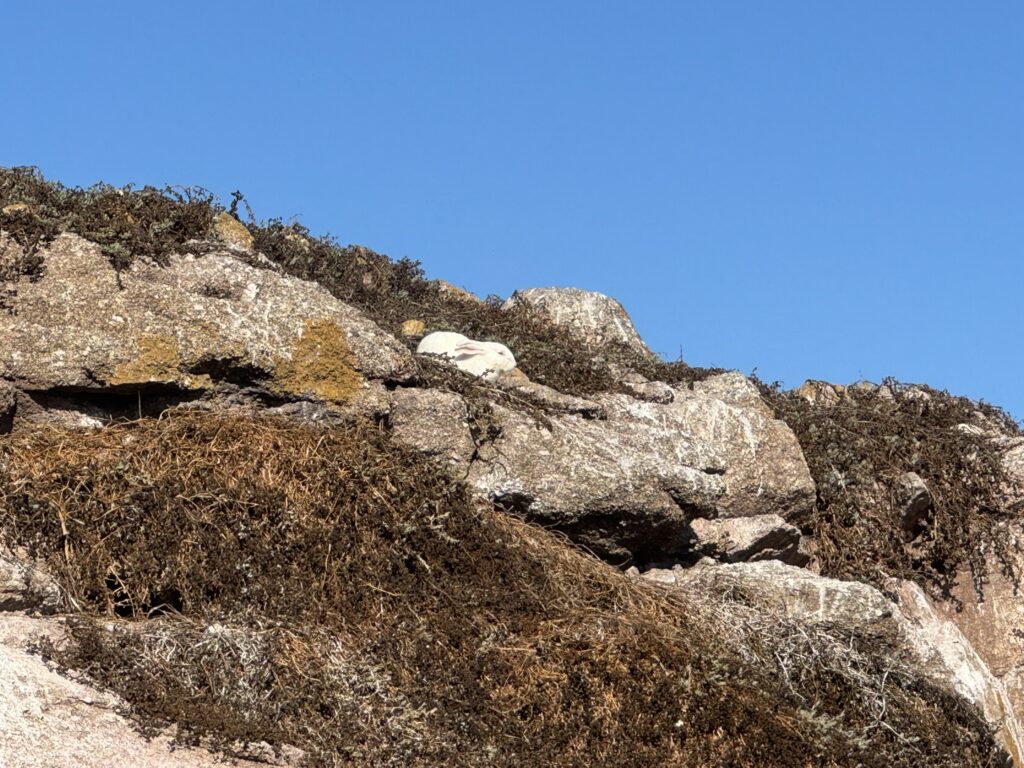
They were introduced along with sheep by Europeans hoping to have a ready supply of food, and learned how to survive on kelp as both a means of food and water. Apparently they have extra large livers to compensate for the salt in their diet. Given their surroundings it’s remarkable they have such white fur!
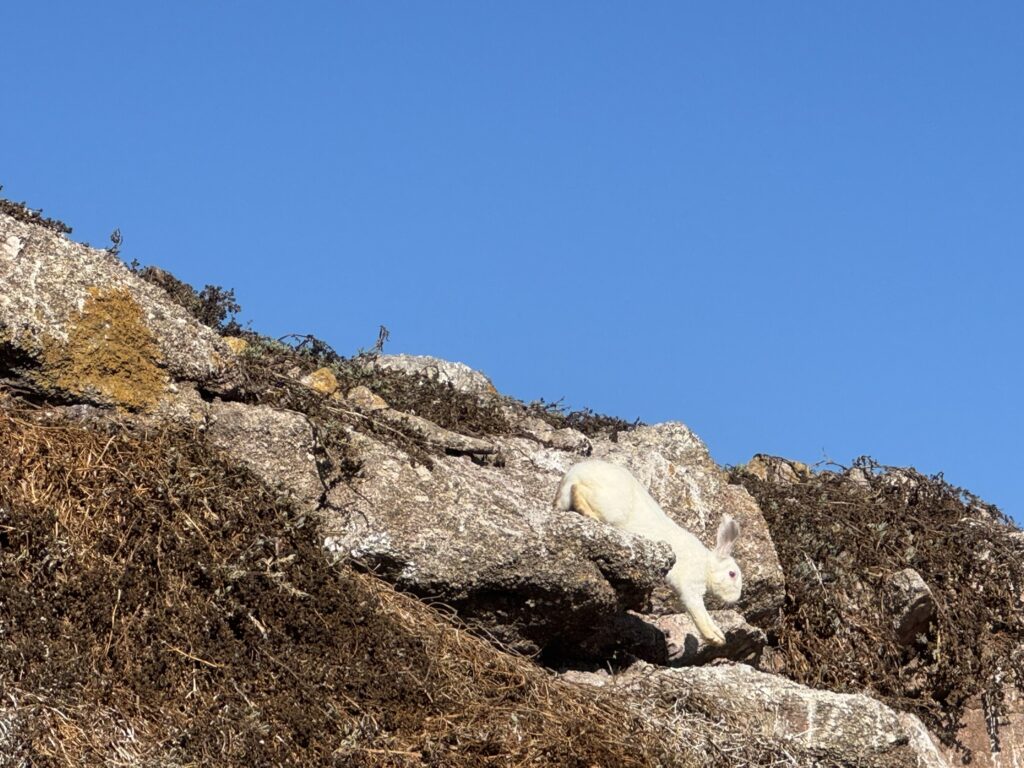
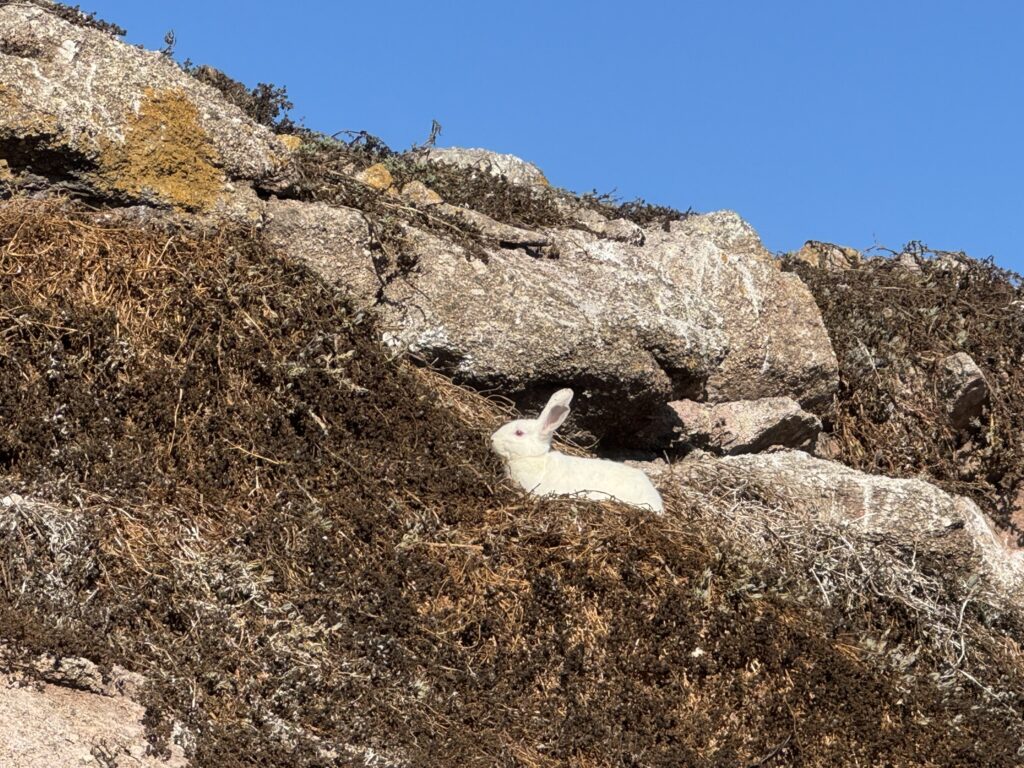
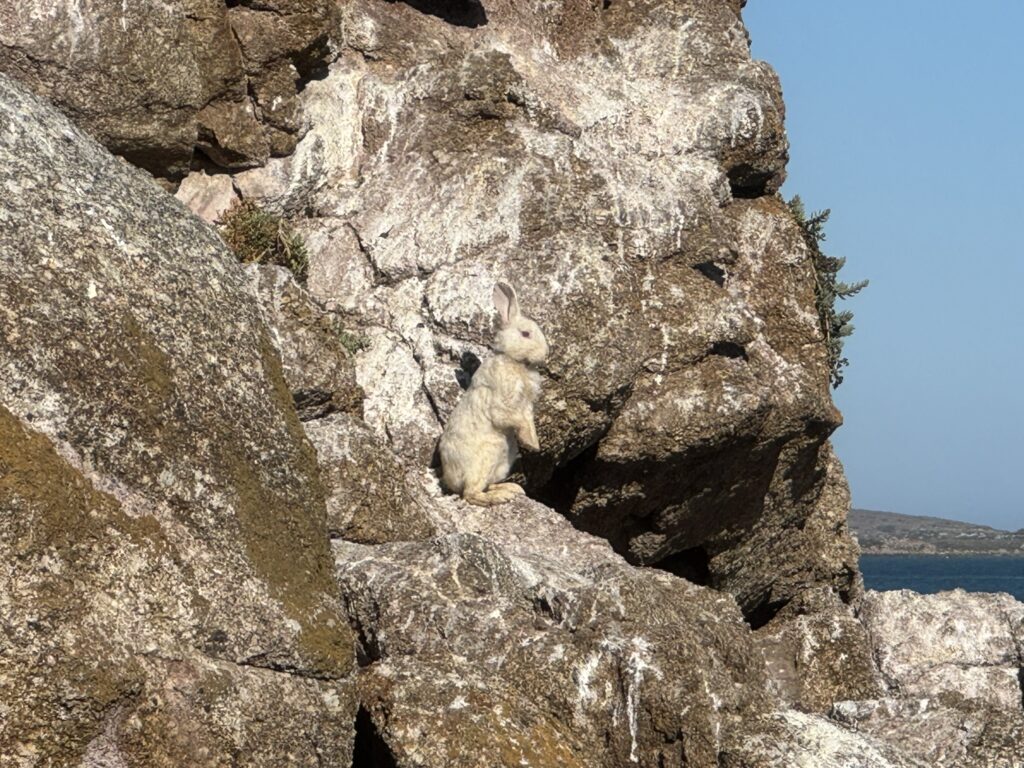
Adorable. My son was thrilled to see them up close.
The winds were picking up further, so we elected to head back to the beach rather than attempting to brave the winds to circumnavigate the island. We’re a bit disappointed but it’s undoubtedly the right call – which is made even more apparent as we struggle to head back toward Langebaan beach:
Along the way we come across a group of seven seals (not photographed) – yet another opportunity to get close to more fantastic wildlife.
We reach the channel, and the winds pick up even further with foot-high swells dashing against the front of the kayak. It’s a struggle but we eventually make our way back on shore.
The upside of our early return is that it gives us more time to hang out at Langebaan beach:
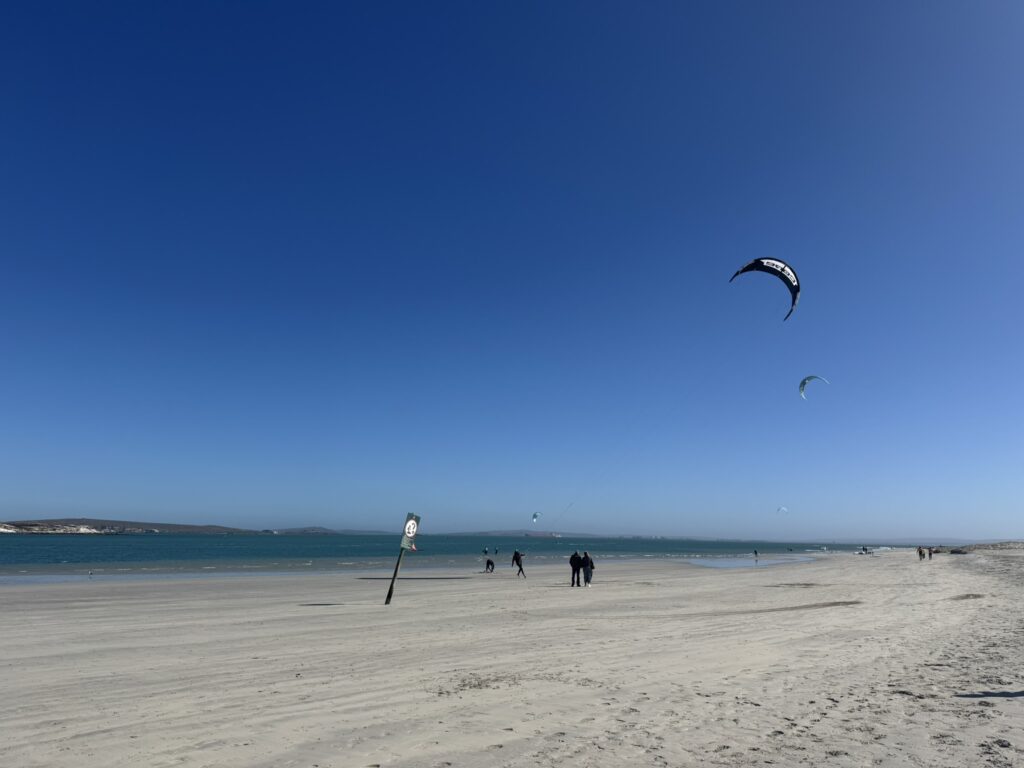
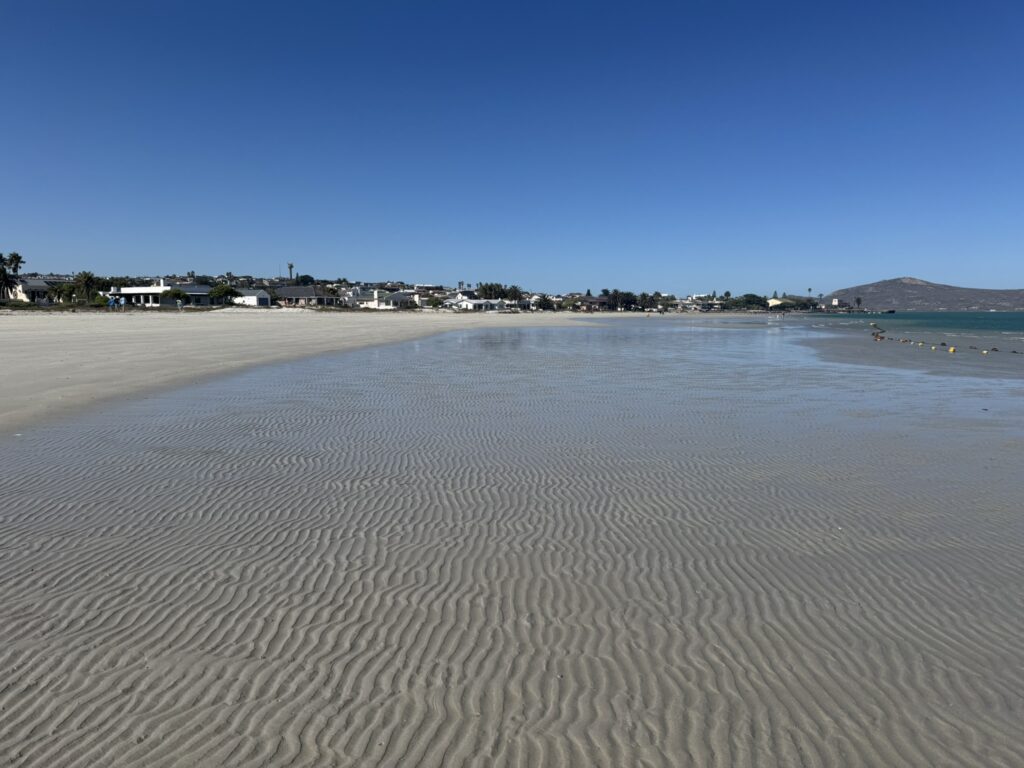
Kids are playing, people are kite surfing, and dogs are taken for walks – it’s a lovely scene, and my son and I are quite happy to just have some time to relax and take it all in.
But not too much time, because we have a second excursion booked for that afternoon. So at around 11:15 am we head back to the ship, where my wife has kindly pre-ordered us some room service pizza.
Shower, lunch, and the world’s shortest power nap – and then it’s time to get dressed and re-board the tender.
This time we manage to get a seat in the cockpit:
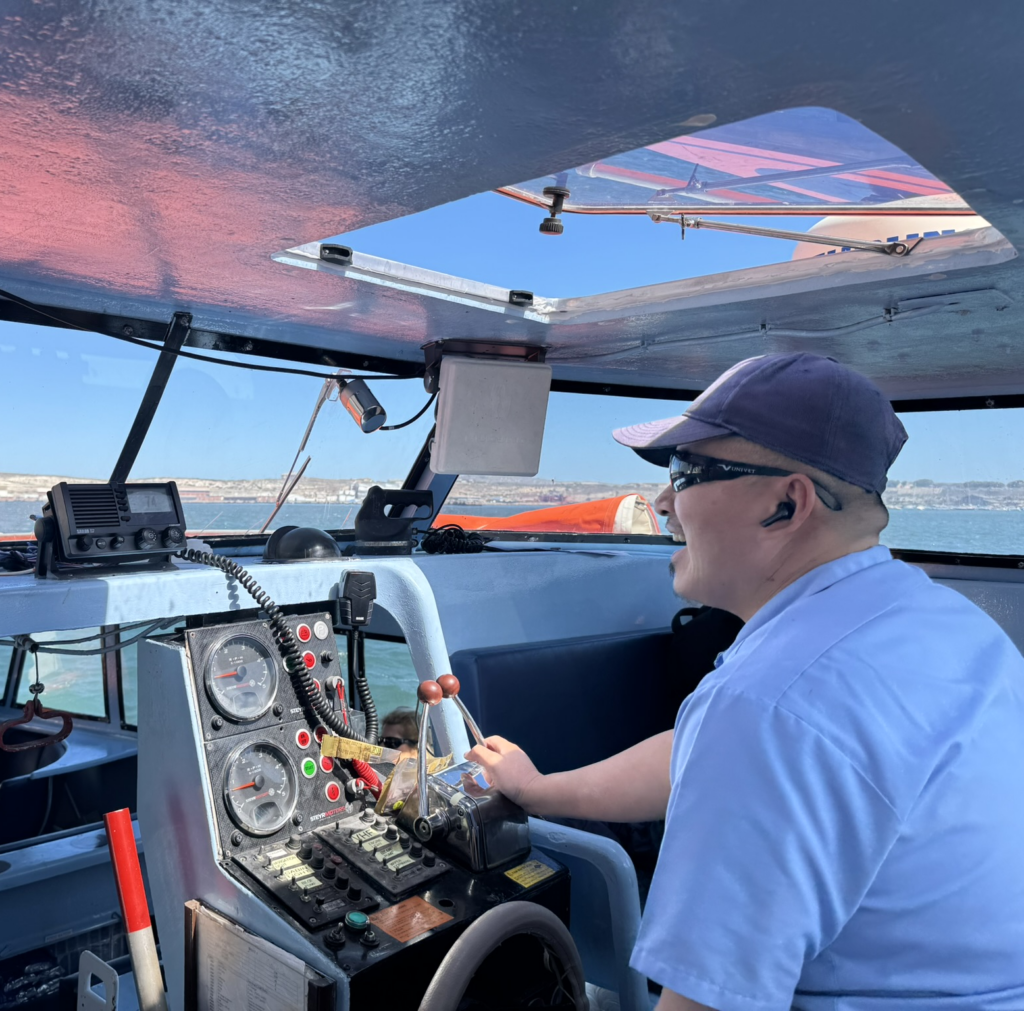
There’s a show waiting for us upon our arrival at the jetty – a seal hunting some fish!
Amazing how the fish leap from the water – but I suppose it’s jump or be eaten.
Then we’re off once more – this time to the West Coast Fossil Park.
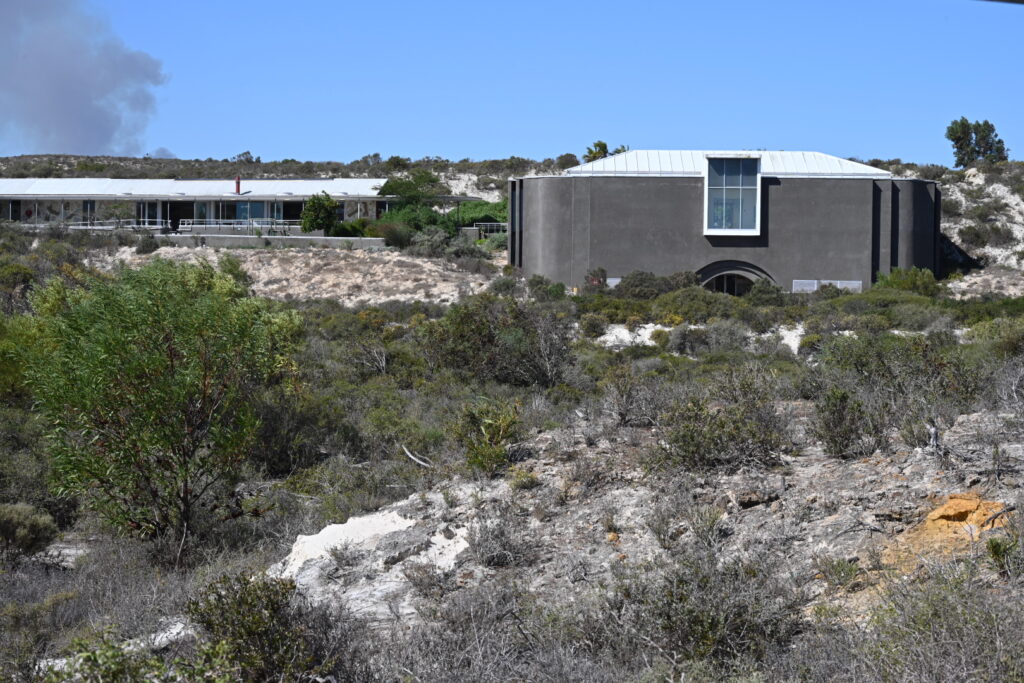
The fossil park is on the site of a former phosphate mining operation dating back to 1943. Although fossils were first discovered in 1958, it took until 1993 before the decision was made to halt mining operations and preserve the area. The park itself first opened in 1998, and the current visitor centre opened in 2018 following a major investment of ZAR 67 million (USD$3.6 million) in lottery funds.
There are a remarkable number of fossils on site, and it’s believed to be one of the most diverse Mio-Pliocene sites in the world. It’s believed these animals were killed during a major flooding event that happened approximatley 5 million years ago, when the tributaries of the Berg river overflowed with sea water. The drowned animals ended up concentrated in the surrounding area, and their remains were prevented from washing out to sea due to the phosphate hill and shape of the estuary.

Our guide Andrea describes these incredible in situ fossil beds
It’s about a 500 metre walk from the visitor’s centre to the fossil beds, and there’s a golf cart available for anyone with mobility challenges.
A huge swath of the fossil beds have been partly exposed and left in situ for visitors to observe. It’s amazing how dense the fossil beds are:
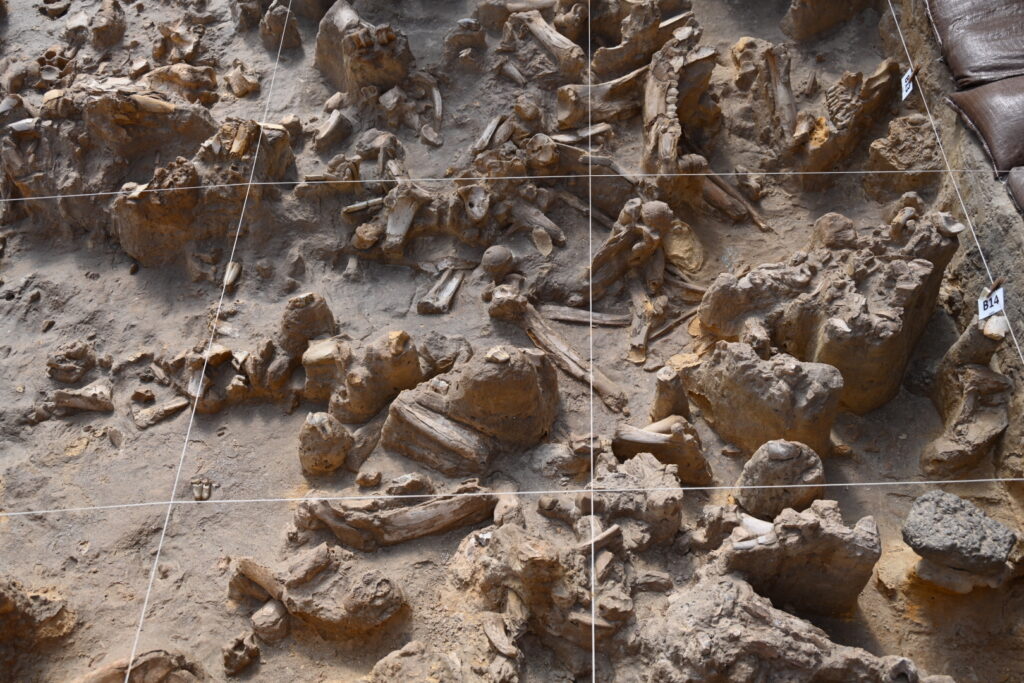
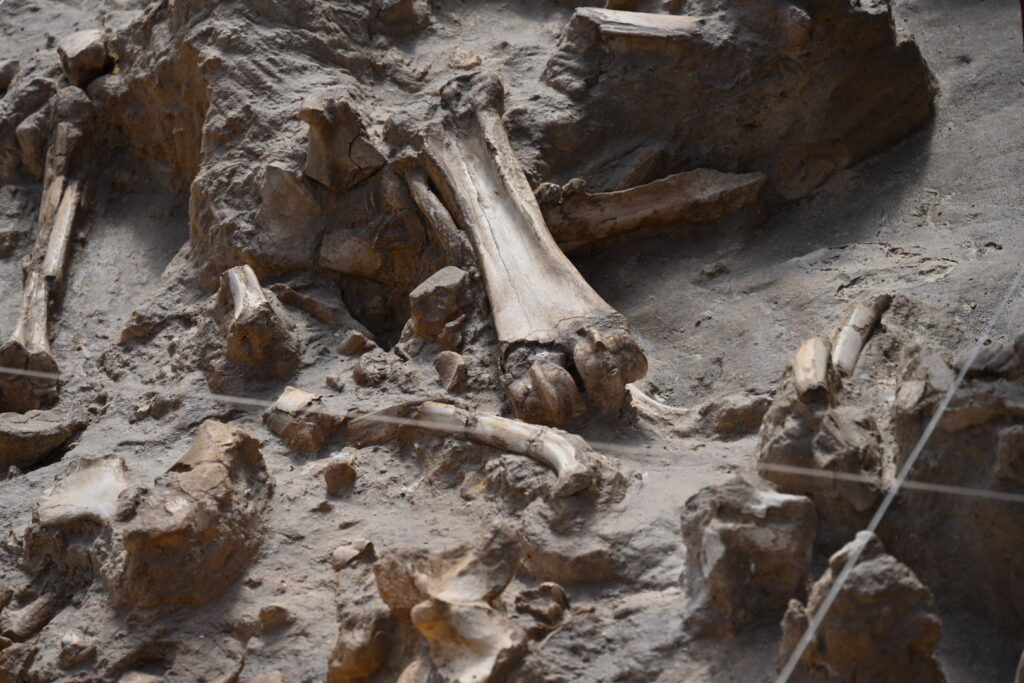
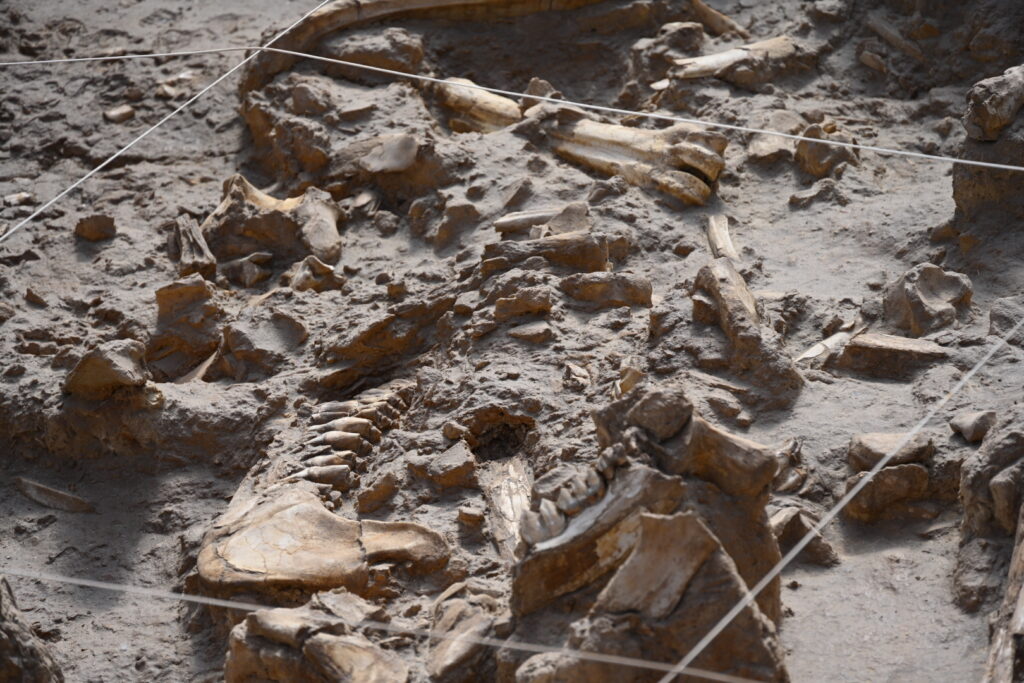

Fossilized animals on the site include the short necked giraffe, hipparion (three toed horses), sabre tooth cats, African bears, and many different types of micro-mammals.
There are also beds that even more densely packed – and even more jumbled as a result:
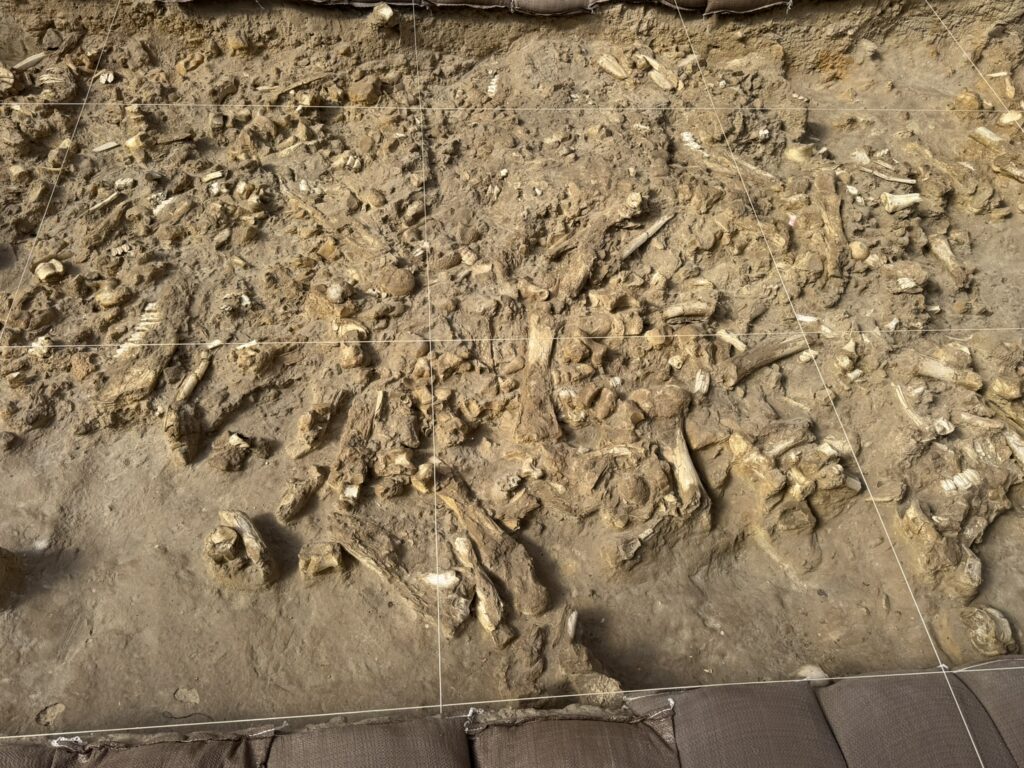
But still some remarkable speciments nevertheless:
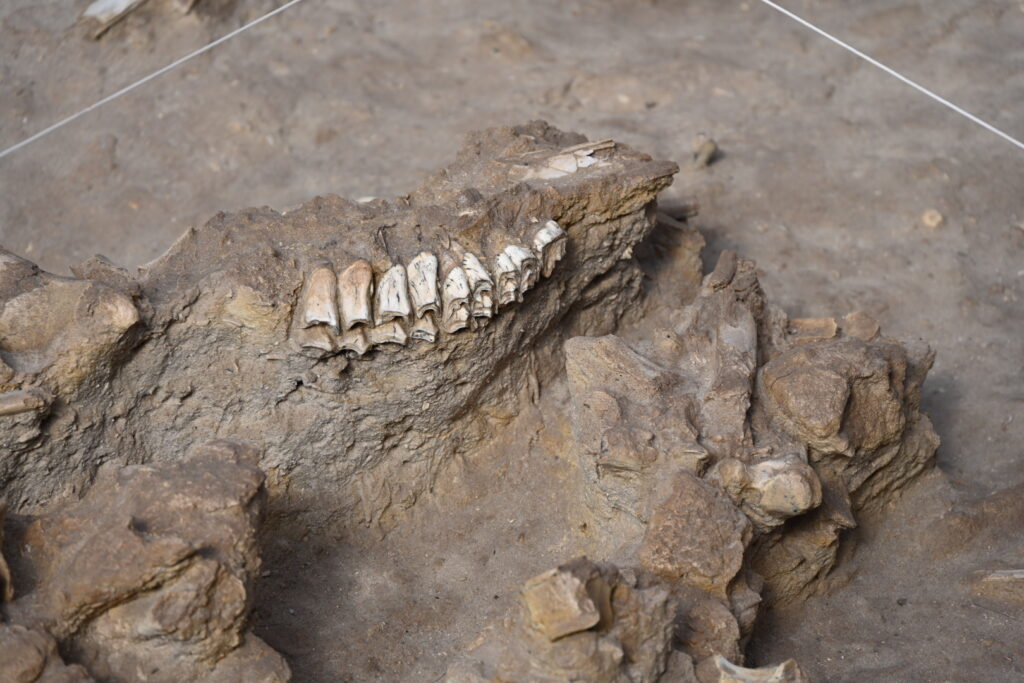
There are some beautiful diagrams on the wall showing how these creatures might have looked when they were alive:

Source: West Coast Fossil Park website – GALLERY — West Coast Fossil Park Blog
There’s also a bed of fossil and rock fragments. Tough to sort through, but still vital work!

Our guide also explains the difference between fossils and bone – fossils have no DNA and no calcium, which means they have been entirely turned into stone.
Time to return to the visitor’s centre:
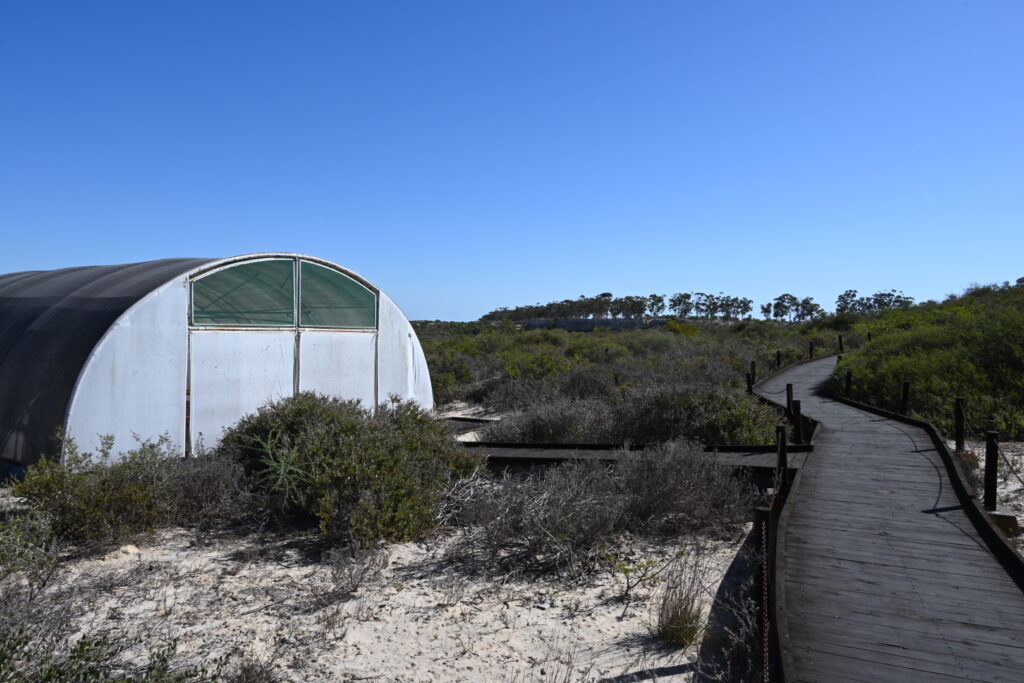
We are greeted at the outside of the museum by a group of children drumming, and who invite us to join in to learn their rhythms. We want to take part but first decide to check out the museum.
There’s beautiful wooden sculptures of some of the prehistoric animals:
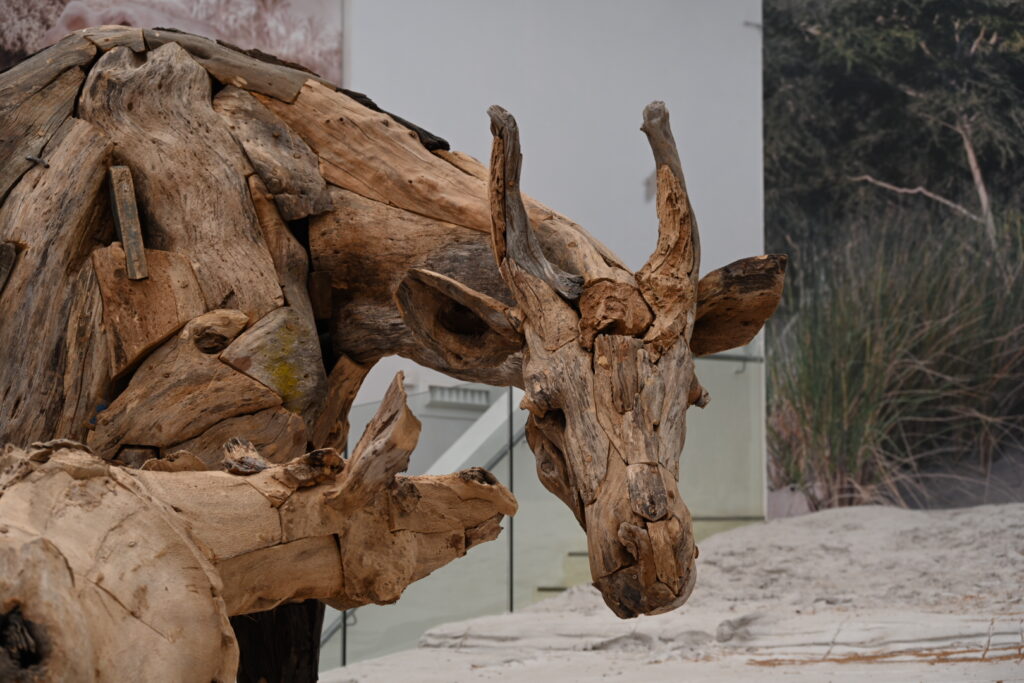
And some stunning work done by illustrator Cedric Hunter, a scientific illustrator at the South African Museum who worked for years to help visualize the animals who lived in Langebaanweg area over 5.2 million years ago:
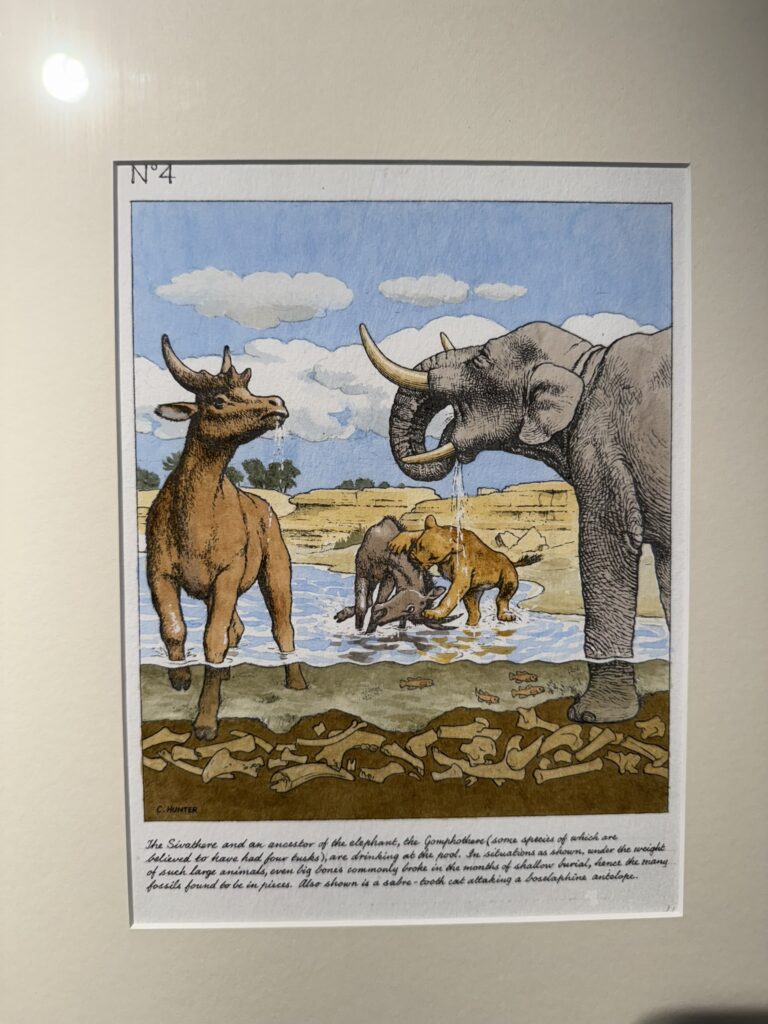
There’s also a remarkable subterranean exhibit:
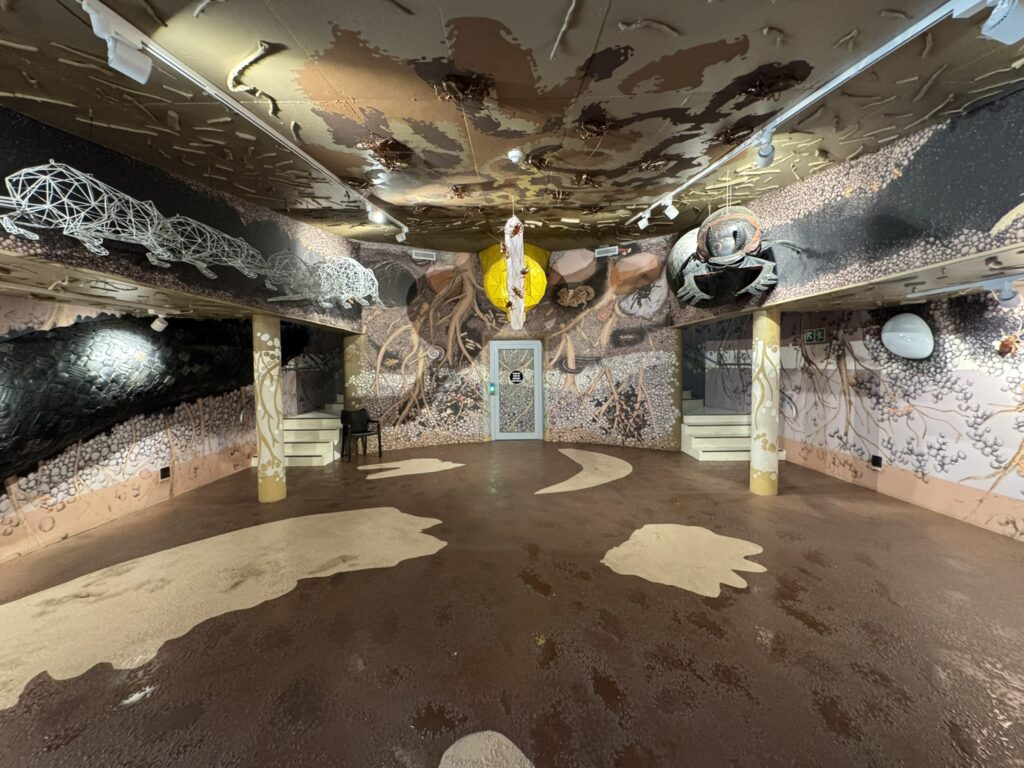
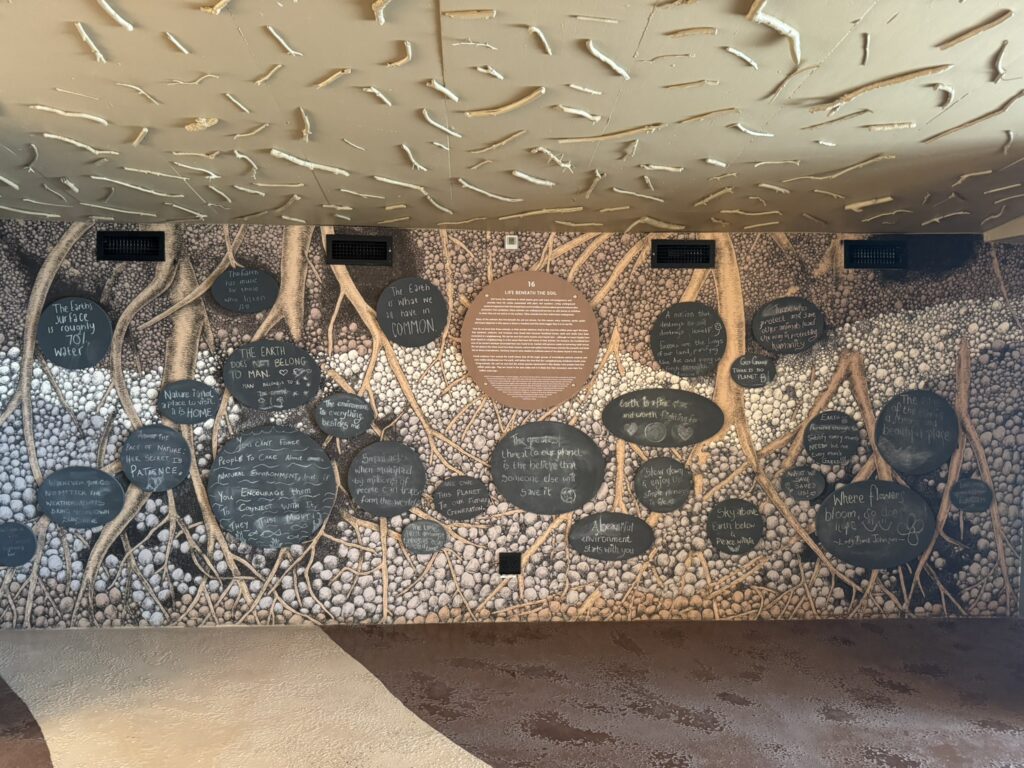
But time – and the drums – thunder onward, so we head upstairs for a drumming session with the local kids. I didn’t feel comfortable taking their pictures, but we did get a fantastic audio recording of their music.
We’d hoped that our kids might also get the chance to participate in one of the mock digs, but we’ve simply run out of time – and I would’ve hated for them to have missed the drumming. So instead it’s time to head back to the parking lot and reboard the bus.
Of course, not everyone is ready to leave at that exact moment – but thankfully the Silversea expedition guides accompanying the tour opt to use a logical approach, and divide the group into an early and a late bus. We’re soon underway, which should give us time to run one last load of laundry before we leave.
Or so we think – we’re not the only ones to come up with this bright idea. I end up waiting out the final 10 minutes of someone else’s washer load, but I do eventually get a much-valued slot in the queue.
Back up to the room so that I can rejoin my family’s furious scramble to finish packing before nightfall is upon us.
But then 6:30 pm arrives, and it’s time for the final recap. We’ve just started with the photo contest when my timer goes – it’s time to switch up laundry. I decide to wait until just after the landscape portion of the photo contest before I dash off. And it’s a good thing I do, because I win!
Here’s my winning entry:
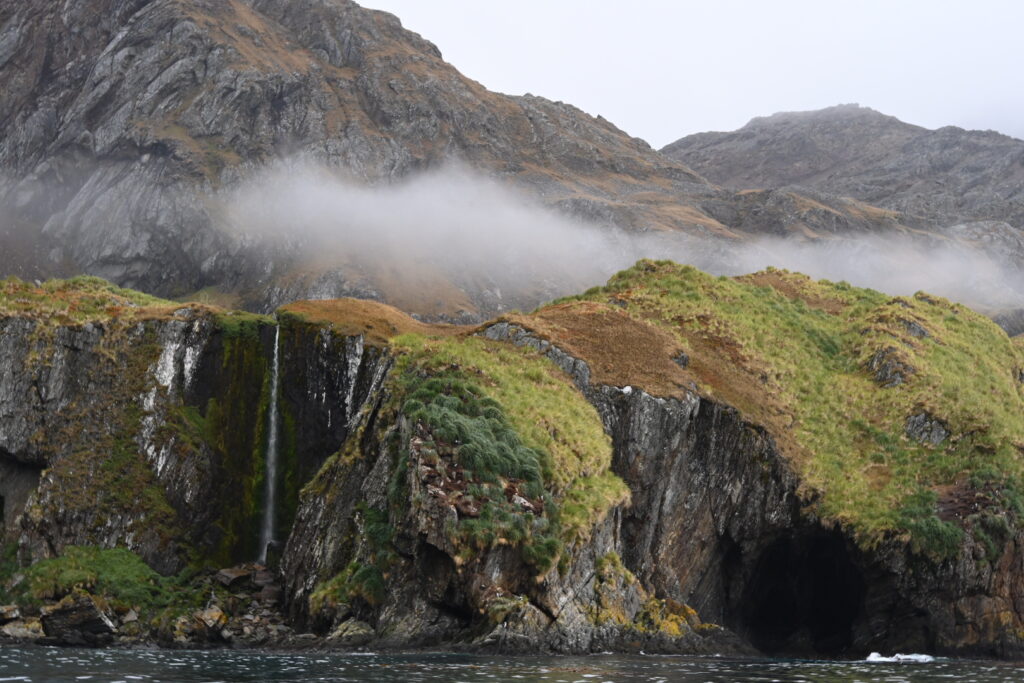
Godthul, South Georgia through the mist – hard to believe I didn’t know what aperture was before this cruise began
Seriously, though, so many of the photos were simply exceptional, and so many of the entries were equally beautiful.
Jamie then went through the itinerary stop-by-stop – which was fun, if not nearly as impactful as the expedition recap videos were before they were discontinued – and he called the expedition team on stage for one final farewell:
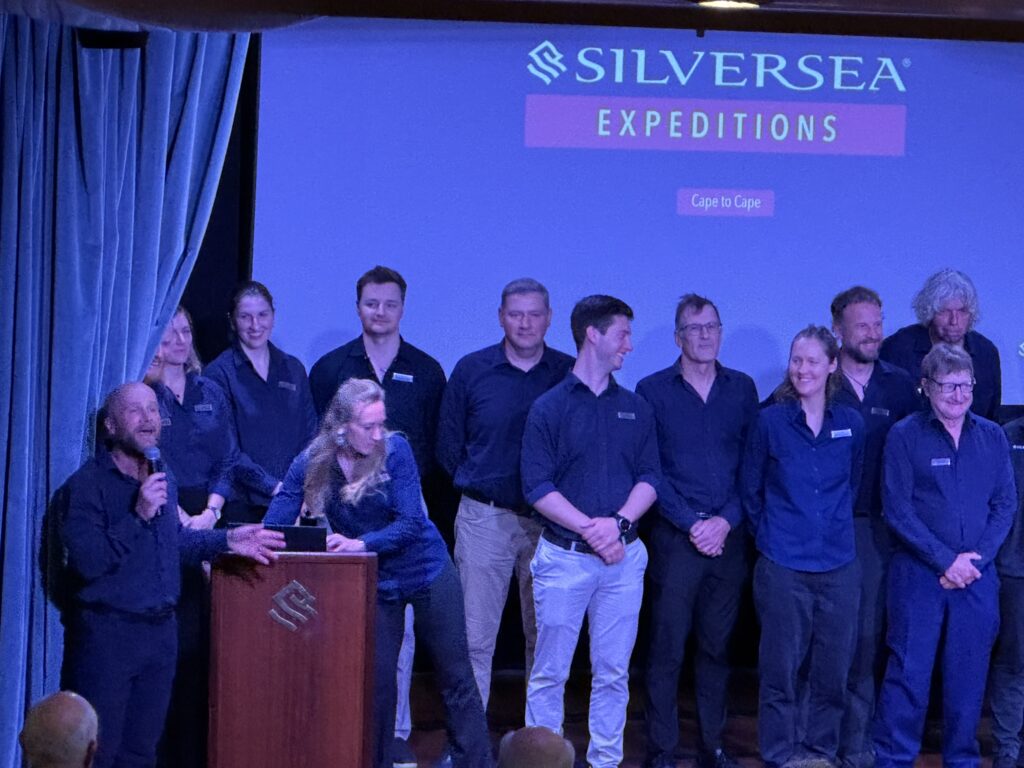
The sun sets in mysterious ways.
Off to the Grill for one last dinner. Swells were close to 3 metres as we set out for Cape Town (and to dump our grey water, I suspect), but that’s just a gentle rocking to us now.
We finish packing and turn out the lights. Sleep claims us almost instantly.
